MGBBT0UBN: A Comprehensive Essay on Business Organisations
VerifiedAdded on 2023/06/18
|7
|1923
|114
Essay
AI Summary
This essay provides an overview of business organizations, focusing on different types such as sole proprietorship, partnerships, and limited liability companies, highlighting their advantages and disadvantages. It further differentiates between tall and flat organizational structures, using Unilever and Tesla as examples. The essay also discusses essential business functions within Unilever, including production, marketing, and finance, emphasizing their roles in achieving organizational goals. Furthermore, it explores the positive impacts of a healthy organizational culture on business growth and success, underlining the importance of employee engagement and retention. The analysis underscores the significance of understanding business organizations for enhanced performance and strategic growth.
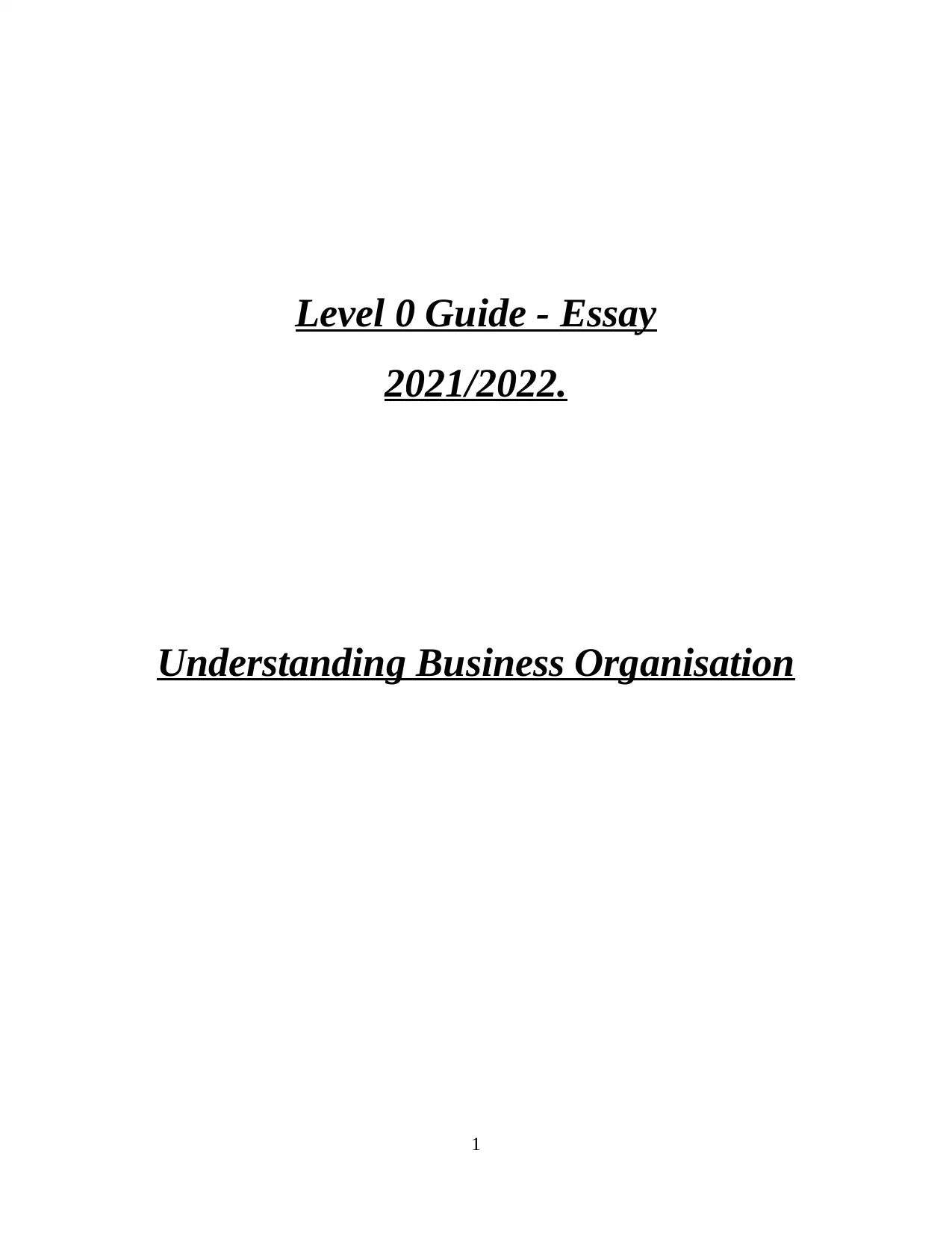
Level 0 Guide - Essay
2021/2022.
Understanding Business Organisation
1
2021/2022.
Understanding Business Organisation
1
Paraphrase This Document
Need a fresh take? Get an instant paraphrase of this document with our AI Paraphraser
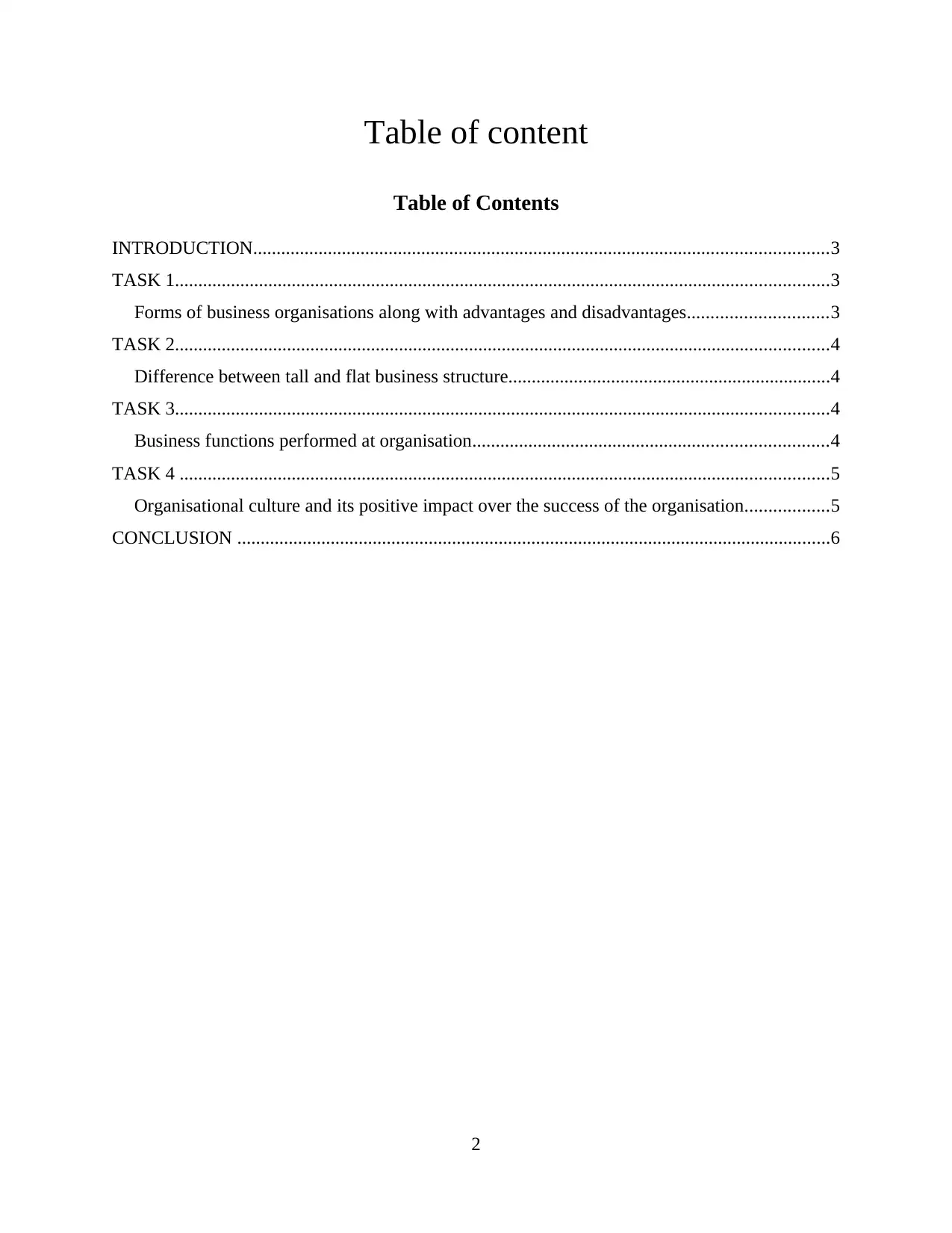
Table of content
Table of Contents
INTRODUCTION...........................................................................................................................3
TASK 1............................................................................................................................................3
Forms of business organisations along with advantages and disadvantages..............................3
TASK 2............................................................................................................................................4
Difference between tall and flat business structure.....................................................................4
TASK 3............................................................................................................................................4
Business functions performed at organisation............................................................................4
TASK 4 ...........................................................................................................................................5
Organisational culture and its positive impact over the success of the organisation..................5
CONCLUSION ...............................................................................................................................6
2
Table of Contents
INTRODUCTION...........................................................................................................................3
TASK 1............................................................................................................................................3
Forms of business organisations along with advantages and disadvantages..............................3
TASK 2............................................................................................................................................4
Difference between tall and flat business structure.....................................................................4
TASK 3............................................................................................................................................4
Business functions performed at organisation............................................................................4
TASK 4 ...........................................................................................................................................5
Organisational culture and its positive impact over the success of the organisation..................5
CONCLUSION ...............................................................................................................................6
2
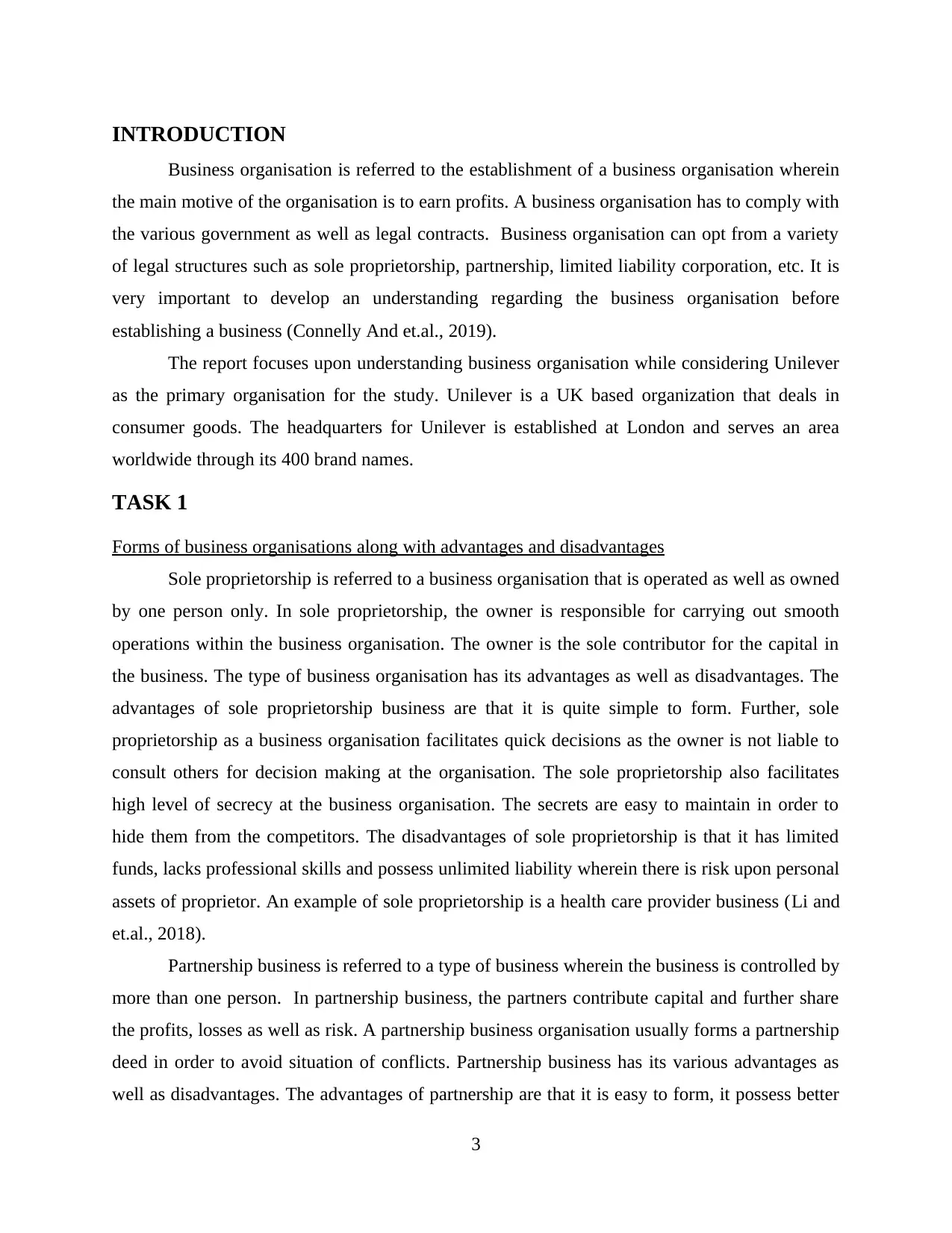
INTRODUCTION
Business organisation is referred to the establishment of a business organisation wherein
the main motive of the organisation is to earn profits. A business organisation has to comply with
the various government as well as legal contracts. Business organisation can opt from a variety
of legal structures such as sole proprietorship, partnership, limited liability corporation, etc. It is
very important to develop an understanding regarding the business organisation before
establishing a business (Connelly And et.al., 2019).
The report focuses upon understanding business organisation while considering Unilever
as the primary organisation for the study. Unilever is a UK based organization that deals in
consumer goods. The headquarters for Unilever is established at London and serves an area
worldwide through its 400 brand names.
TASK 1
Forms of business organisations along with advantages and disadvantages
Sole proprietorship is referred to a business organisation that is operated as well as owned
by one person only. In sole proprietorship, the owner is responsible for carrying out smooth
operations within the business organisation. The owner is the sole contributor for the capital in
the business. The type of business organisation has its advantages as well as disadvantages. The
advantages of sole proprietorship business are that it is quite simple to form. Further, sole
proprietorship as a business organisation facilitates quick decisions as the owner is not liable to
consult others for decision making at the organisation. The sole proprietorship also facilitates
high level of secrecy at the business organisation. The secrets are easy to maintain in order to
hide them from the competitors. The disadvantages of sole proprietorship is that it has limited
funds, lacks professional skills and possess unlimited liability wherein there is risk upon personal
assets of proprietor. An example of sole proprietorship is a health care provider business (Li and
et.al., 2018).
Partnership business is referred to a type of business wherein the business is controlled by
more than one person. In partnership business, the partners contribute capital and further share
the profits, losses as well as risk. A partnership business organisation usually forms a partnership
deed in order to avoid situation of conflicts. Partnership business has its various advantages as
well as disadvantages. The advantages of partnership are that it is easy to form, it possess better
3
Business organisation is referred to the establishment of a business organisation wherein
the main motive of the organisation is to earn profits. A business organisation has to comply with
the various government as well as legal contracts. Business organisation can opt from a variety
of legal structures such as sole proprietorship, partnership, limited liability corporation, etc. It is
very important to develop an understanding regarding the business organisation before
establishing a business (Connelly And et.al., 2019).
The report focuses upon understanding business organisation while considering Unilever
as the primary organisation for the study. Unilever is a UK based organization that deals in
consumer goods. The headquarters for Unilever is established at London and serves an area
worldwide through its 400 brand names.
TASK 1
Forms of business organisations along with advantages and disadvantages
Sole proprietorship is referred to a business organisation that is operated as well as owned
by one person only. In sole proprietorship, the owner is responsible for carrying out smooth
operations within the business organisation. The owner is the sole contributor for the capital in
the business. The type of business organisation has its advantages as well as disadvantages. The
advantages of sole proprietorship business are that it is quite simple to form. Further, sole
proprietorship as a business organisation facilitates quick decisions as the owner is not liable to
consult others for decision making at the organisation. The sole proprietorship also facilitates
high level of secrecy at the business organisation. The secrets are easy to maintain in order to
hide them from the competitors. The disadvantages of sole proprietorship is that it has limited
funds, lacks professional skills and possess unlimited liability wherein there is risk upon personal
assets of proprietor. An example of sole proprietorship is a health care provider business (Li and
et.al., 2018).
Partnership business is referred to a type of business wherein the business is controlled by
more than one person. In partnership business, the partners contribute capital and further share
the profits, losses as well as risk. A partnership business organisation usually forms a partnership
deed in order to avoid situation of conflicts. Partnership business has its various advantages as
well as disadvantages. The advantages of partnership are that it is easy to form, it possess better
3
⊘ This is a preview!⊘
Do you want full access?
Subscribe today to unlock all pages.

Trusted by 1+ million students worldwide
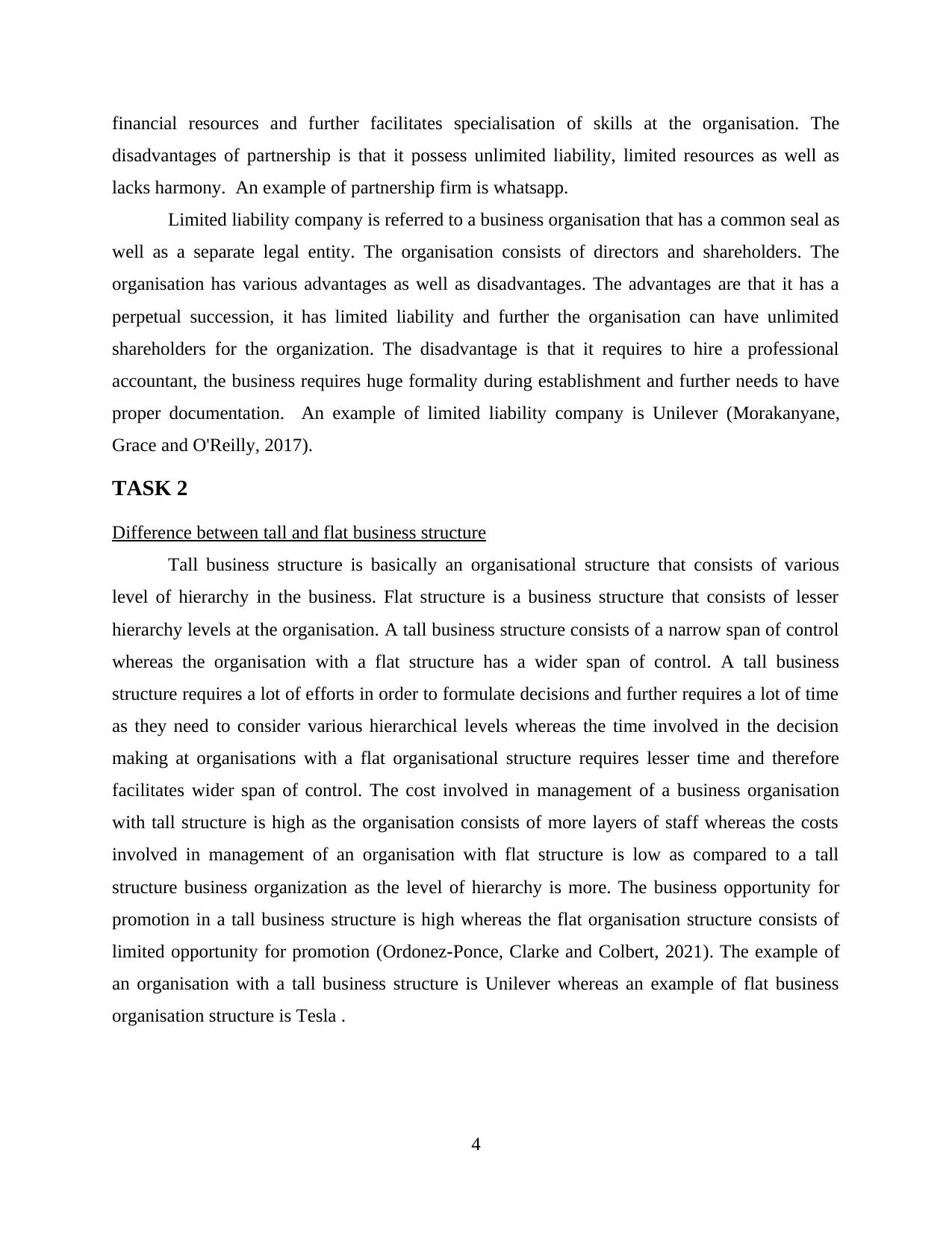
financial resources and further facilitates specialisation of skills at the organisation. The
disadvantages of partnership is that it possess unlimited liability, limited resources as well as
lacks harmony. An example of partnership firm is whatsapp.
Limited liability company is referred to a business organisation that has a common seal as
well as a separate legal entity. The organisation consists of directors and shareholders. The
organisation has various advantages as well as disadvantages. The advantages are that it has a
perpetual succession, it has limited liability and further the organisation can have unlimited
shareholders for the organization. The disadvantage is that it requires to hire a professional
accountant, the business requires huge formality during establishment and further needs to have
proper documentation. An example of limited liability company is Unilever (Morakanyane,
Grace and O'Reilly, 2017).
TASK 2
Difference between tall and flat business structure
Tall business structure is basically an organisational structure that consists of various
level of hierarchy in the business. Flat structure is a business structure that consists of lesser
hierarchy levels at the organisation. A tall business structure consists of a narrow span of control
whereas the organisation with a flat structure has a wider span of control. A tall business
structure requires a lot of efforts in order to formulate decisions and further requires a lot of time
as they need to consider various hierarchical levels whereas the time involved in the decision
making at organisations with a flat organisational structure requires lesser time and therefore
facilitates wider span of control. The cost involved in management of a business organisation
with tall structure is high as the organisation consists of more layers of staff whereas the costs
involved in management of an organisation with flat structure is low as compared to a tall
structure business organization as the level of hierarchy is more. The business opportunity for
promotion in a tall business structure is high whereas the flat organisation structure consists of
limited opportunity for promotion (Ordonez-Ponce, Clarke and Colbert, 2021). The example of
an organisation with a tall business structure is Unilever whereas an example of flat business
organisation structure is Tesla .
4
disadvantages of partnership is that it possess unlimited liability, limited resources as well as
lacks harmony. An example of partnership firm is whatsapp.
Limited liability company is referred to a business organisation that has a common seal as
well as a separate legal entity. The organisation consists of directors and shareholders. The
organisation has various advantages as well as disadvantages. The advantages are that it has a
perpetual succession, it has limited liability and further the organisation can have unlimited
shareholders for the organization. The disadvantage is that it requires to hire a professional
accountant, the business requires huge formality during establishment and further needs to have
proper documentation. An example of limited liability company is Unilever (Morakanyane,
Grace and O'Reilly, 2017).
TASK 2
Difference between tall and flat business structure
Tall business structure is basically an organisational structure that consists of various
level of hierarchy in the business. Flat structure is a business structure that consists of lesser
hierarchy levels at the organisation. A tall business structure consists of a narrow span of control
whereas the organisation with a flat structure has a wider span of control. A tall business
structure requires a lot of efforts in order to formulate decisions and further requires a lot of time
as they need to consider various hierarchical levels whereas the time involved in the decision
making at organisations with a flat organisational structure requires lesser time and therefore
facilitates wider span of control. The cost involved in management of a business organisation
with tall structure is high as the organisation consists of more layers of staff whereas the costs
involved in management of an organisation with flat structure is low as compared to a tall
structure business organization as the level of hierarchy is more. The business opportunity for
promotion in a tall business structure is high whereas the flat organisation structure consists of
limited opportunity for promotion (Ordonez-Ponce, Clarke and Colbert, 2021). The example of
an organisation with a tall business structure is Unilever whereas an example of flat business
organisation structure is Tesla .
4
Paraphrase This Document
Need a fresh take? Get an instant paraphrase of this document with our AI Paraphraser
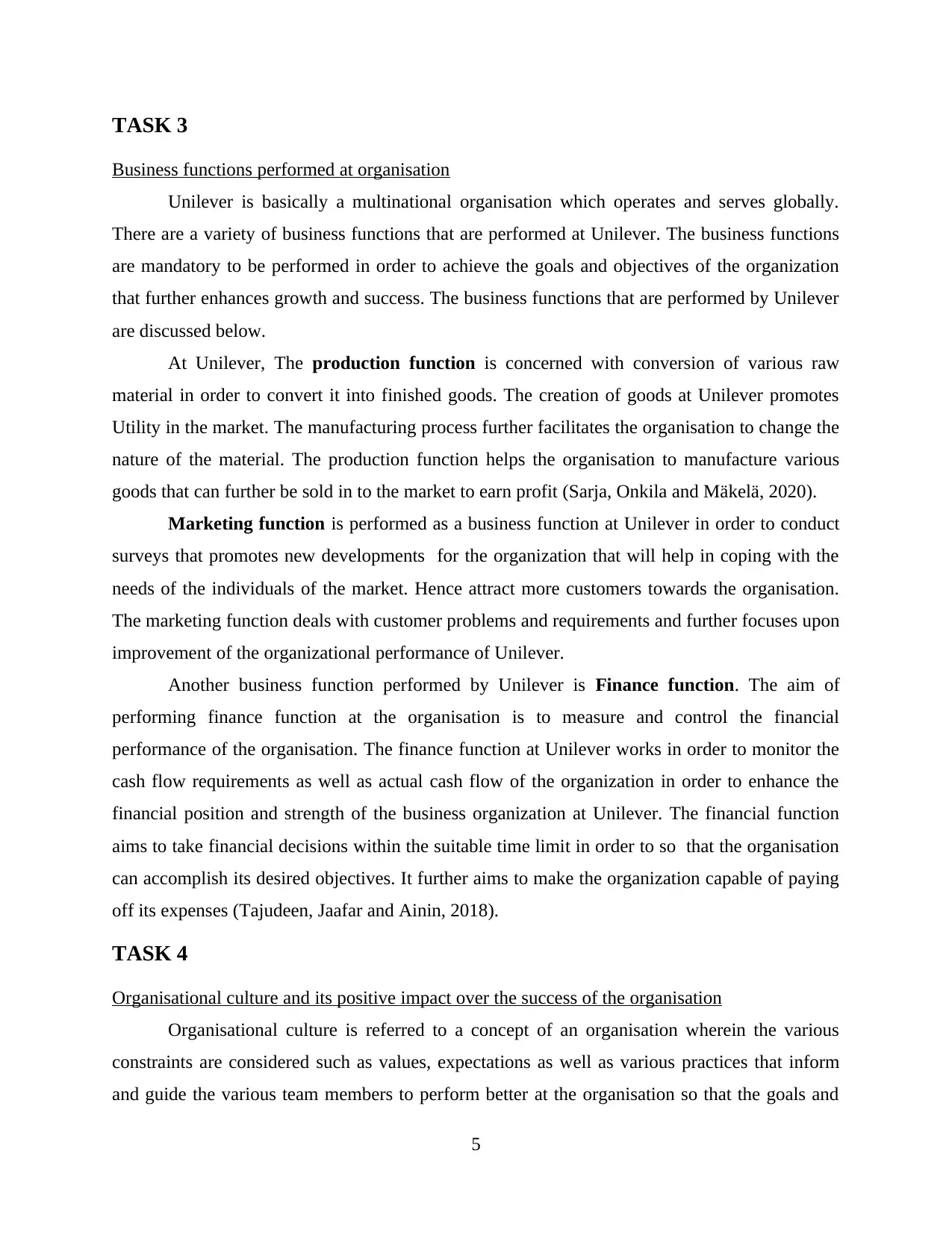
TASK 3
Business functions performed at organisation
Unilever is basically a multinational organisation which operates and serves globally.
There are a variety of business functions that are performed at Unilever. The business functions
are mandatory to be performed in order to achieve the goals and objectives of the organization
that further enhances growth and success. The business functions that are performed by Unilever
are discussed below.
At Unilever, The production function is concerned with conversion of various raw
material in order to convert it into finished goods. The creation of goods at Unilever promotes
Utility in the market. The manufacturing process further facilitates the organisation to change the
nature of the material. The production function helps the organisation to manufacture various
goods that can further be sold in to the market to earn profit (Sarja, Onkila and Mäkelä, 2020).
Marketing function is performed as a business function at Unilever in order to conduct
surveys that promotes new developments for the organization that will help in coping with the
needs of the individuals of the market. Hence attract more customers towards the organisation.
The marketing function deals with customer problems and requirements and further focuses upon
improvement of the organizational performance of Unilever.
Another business function performed by Unilever is Finance function. The aim of
performing finance function at the organisation is to measure and control the financial
performance of the organisation. The finance function at Unilever works in order to monitor the
cash flow requirements as well as actual cash flow of the organization in order to enhance the
financial position and strength of the business organization at Unilever. The financial function
aims to take financial decisions within the suitable time limit in order to so that the organisation
can accomplish its desired objectives. It further aims to make the organization capable of paying
off its expenses (Tajudeen, Jaafar and Ainin, 2018).
TASK 4
Organisational culture and its positive impact over the success of the organisation
Organisational culture is referred to a concept of an organisation wherein the various
constraints are considered such as values, expectations as well as various practices that inform
and guide the various team members to perform better at the organisation so that the goals and
5
Business functions performed at organisation
Unilever is basically a multinational organisation which operates and serves globally.
There are a variety of business functions that are performed at Unilever. The business functions
are mandatory to be performed in order to achieve the goals and objectives of the organization
that further enhances growth and success. The business functions that are performed by Unilever
are discussed below.
At Unilever, The production function is concerned with conversion of various raw
material in order to convert it into finished goods. The creation of goods at Unilever promotes
Utility in the market. The manufacturing process further facilitates the organisation to change the
nature of the material. The production function helps the organisation to manufacture various
goods that can further be sold in to the market to earn profit (Sarja, Onkila and Mäkelä, 2020).
Marketing function is performed as a business function at Unilever in order to conduct
surveys that promotes new developments for the organization that will help in coping with the
needs of the individuals of the market. Hence attract more customers towards the organisation.
The marketing function deals with customer problems and requirements and further focuses upon
improvement of the organizational performance of Unilever.
Another business function performed by Unilever is Finance function. The aim of
performing finance function at the organisation is to measure and control the financial
performance of the organisation. The finance function at Unilever works in order to monitor the
cash flow requirements as well as actual cash flow of the organization in order to enhance the
financial position and strength of the business organization at Unilever. The financial function
aims to take financial decisions within the suitable time limit in order to so that the organisation
can accomplish its desired objectives. It further aims to make the organization capable of paying
off its expenses (Tajudeen, Jaafar and Ainin, 2018).
TASK 4
Organisational culture and its positive impact over the success of the organisation
Organisational culture is referred to a concept of an organisation wherein the various
constraints are considered such as values, expectations as well as various practices that inform
and guide the various team members to perform better at the organisation so that the goals and
5
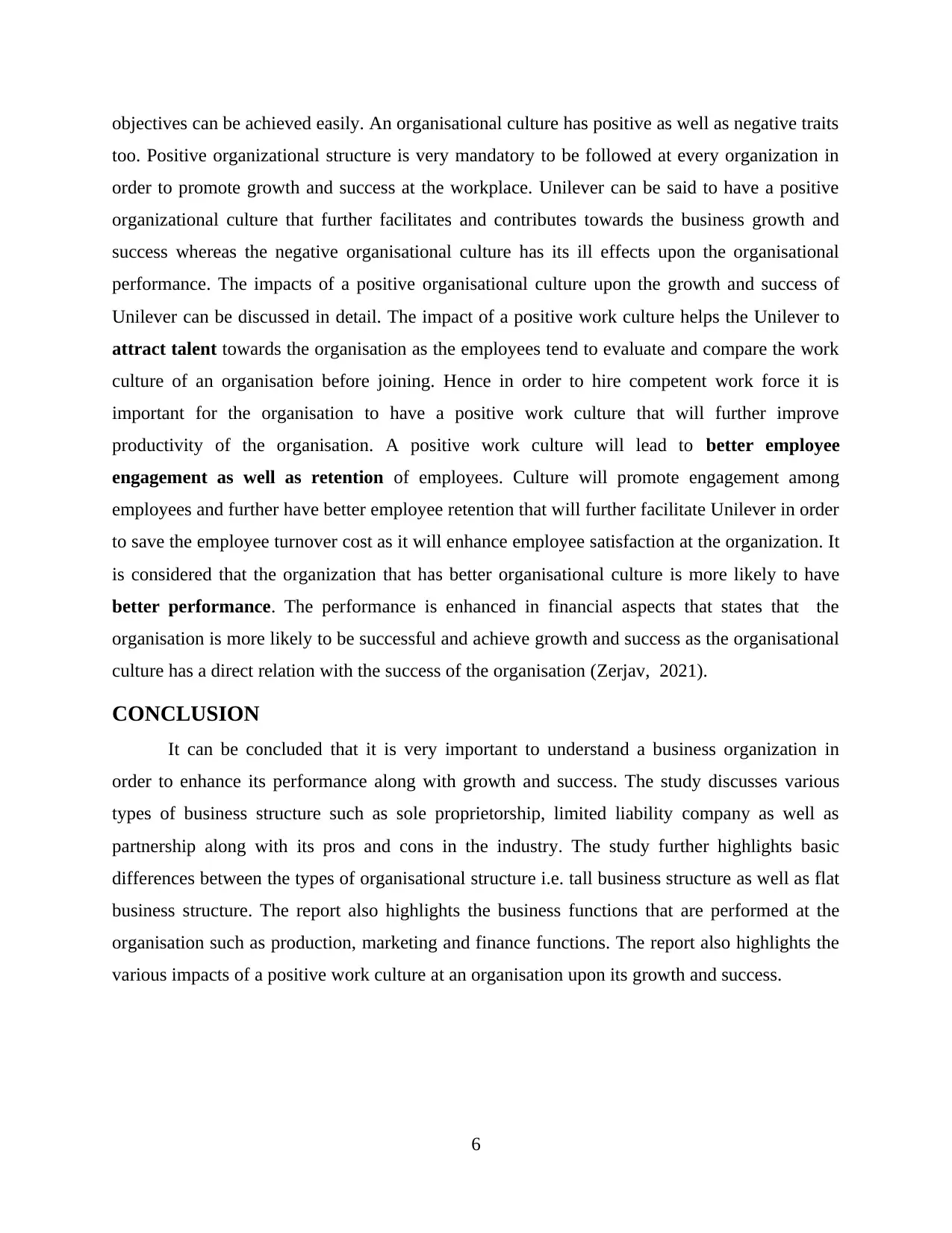
objectives can be achieved easily. An organisational culture has positive as well as negative traits
too. Positive organizational structure is very mandatory to be followed at every organization in
order to promote growth and success at the workplace. Unilever can be said to have a positive
organizational culture that further facilitates and contributes towards the business growth and
success whereas the negative organisational culture has its ill effects upon the organisational
performance. The impacts of a positive organisational culture upon the growth and success of
Unilever can be discussed in detail. The impact of a positive work culture helps the Unilever to
attract talent towards the organisation as the employees tend to evaluate and compare the work
culture of an organisation before joining. Hence in order to hire competent work force it is
important for the organisation to have a positive work culture that will further improve
productivity of the organisation. A positive work culture will lead to better employee
engagement as well as retention of employees. Culture will promote engagement among
employees and further have better employee retention that will further facilitate Unilever in order
to save the employee turnover cost as it will enhance employee satisfaction at the organization. It
is considered that the organization that has better organisational culture is more likely to have
better performance. The performance is enhanced in financial aspects that states that the
organisation is more likely to be successful and achieve growth and success as the organisational
culture has a direct relation with the success of the organisation (Zerjav, 2021).
CONCLUSION
It can be concluded that it is very important to understand a business organization in
order to enhance its performance along with growth and success. The study discusses various
types of business structure such as sole proprietorship, limited liability company as well as
partnership along with its pros and cons in the industry. The study further highlights basic
differences between the types of organisational structure i.e. tall business structure as well as flat
business structure. The report also highlights the business functions that are performed at the
organisation such as production, marketing and finance functions. The report also highlights the
various impacts of a positive work culture at an organisation upon its growth and success.
6
too. Positive organizational structure is very mandatory to be followed at every organization in
order to promote growth and success at the workplace. Unilever can be said to have a positive
organizational culture that further facilitates and contributes towards the business growth and
success whereas the negative organisational culture has its ill effects upon the organisational
performance. The impacts of a positive organisational culture upon the growth and success of
Unilever can be discussed in detail. The impact of a positive work culture helps the Unilever to
attract talent towards the organisation as the employees tend to evaluate and compare the work
culture of an organisation before joining. Hence in order to hire competent work force it is
important for the organisation to have a positive work culture that will further improve
productivity of the organisation. A positive work culture will lead to better employee
engagement as well as retention of employees. Culture will promote engagement among
employees and further have better employee retention that will further facilitate Unilever in order
to save the employee turnover cost as it will enhance employee satisfaction at the organization. It
is considered that the organization that has better organisational culture is more likely to have
better performance. The performance is enhanced in financial aspects that states that the
organisation is more likely to be successful and achieve growth and success as the organisational
culture has a direct relation with the success of the organisation (Zerjav, 2021).
CONCLUSION
It can be concluded that it is very important to understand a business organization in
order to enhance its performance along with growth and success. The study discusses various
types of business structure such as sole proprietorship, limited liability company as well as
partnership along with its pros and cons in the industry. The study further highlights basic
differences between the types of organisational structure i.e. tall business structure as well as flat
business structure. The report also highlights the business functions that are performed at the
organisation such as production, marketing and finance functions. The report also highlights the
various impacts of a positive work culture at an organisation upon its growth and success.
6
⊘ This is a preview!⊘
Do you want full access?
Subscribe today to unlock all pages.

Trusted by 1+ million students worldwide
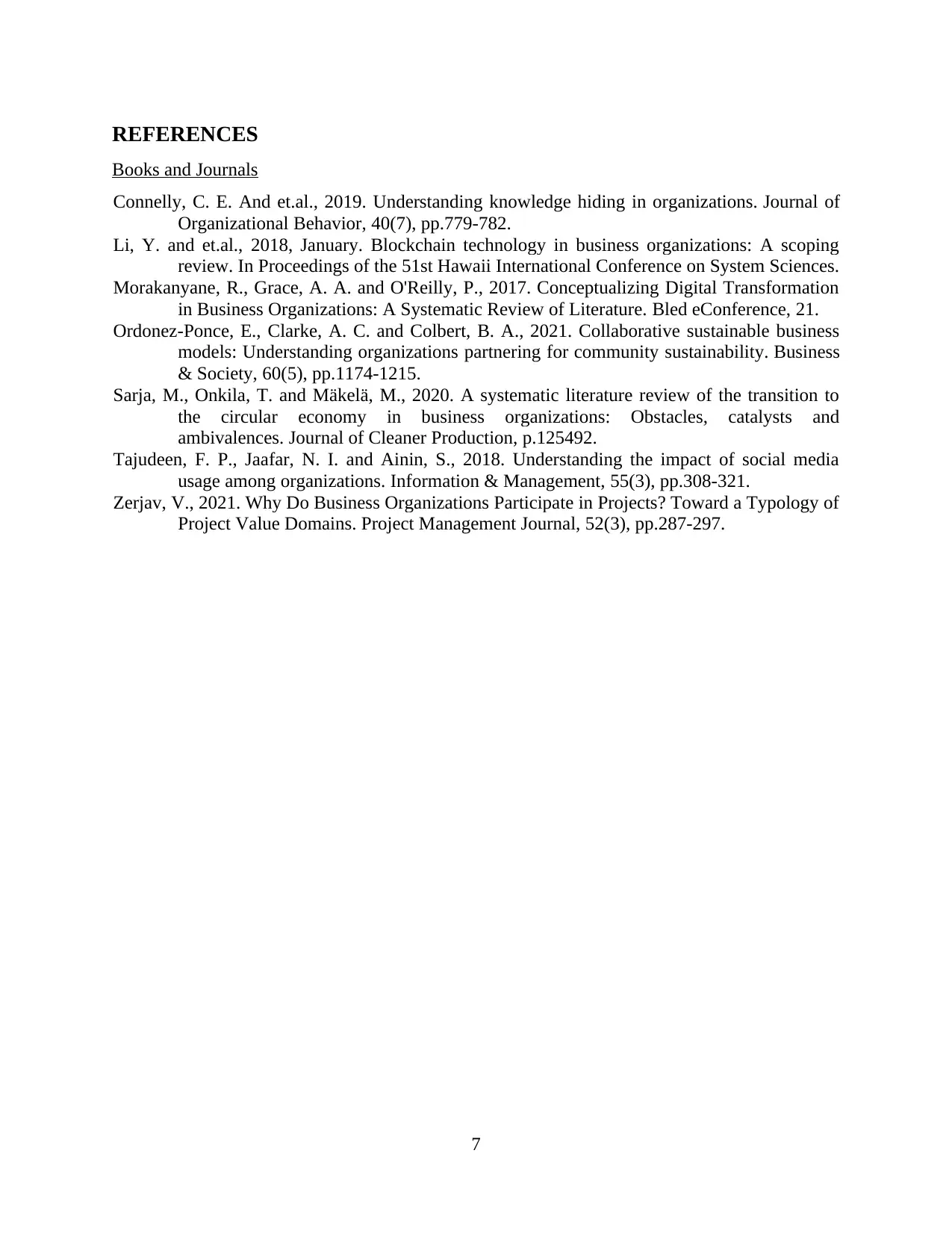
REFERENCES
Books and Journals
Connelly, C. E. And et.al., 2019. Understanding knowledge hiding in organizations. Journal of
Organizational Behavior, 40(7), pp.779-782.
Li, Y. and et.al., 2018, January. Blockchain technology in business organizations: A scoping
review. In Proceedings of the 51st Hawaii International Conference on System Sciences.
Morakanyane, R., Grace, A. A. and O'Reilly, P., 2017. Conceptualizing Digital Transformation
in Business Organizations: A Systematic Review of Literature. Bled eConference, 21.
Ordonez-Ponce, E., Clarke, A. C. and Colbert, B. A., 2021. Collaborative sustainable business
models: Understanding organizations partnering for community sustainability. Business
& Society, 60(5), pp.1174-1215.
Sarja, M., Onkila, T. and Mäkelä, M., 2020. A systematic literature review of the transition to
the circular economy in business organizations: Obstacles, catalysts and
ambivalences. Journal of Cleaner Production, p.125492.
Tajudeen, F. P., Jaafar, N. I. and Ainin, S., 2018. Understanding the impact of social media
usage among organizations. Information & Management, 55(3), pp.308-321.
Zerjav, V., 2021. Why Do Business Organizations Participate in Projects? Toward a Typology of
Project Value Domains. Project Management Journal, 52(3), pp.287-297.
7
Books and Journals
Connelly, C. E. And et.al., 2019. Understanding knowledge hiding in organizations. Journal of
Organizational Behavior, 40(7), pp.779-782.
Li, Y. and et.al., 2018, January. Blockchain technology in business organizations: A scoping
review. In Proceedings of the 51st Hawaii International Conference on System Sciences.
Morakanyane, R., Grace, A. A. and O'Reilly, P., 2017. Conceptualizing Digital Transformation
in Business Organizations: A Systematic Review of Literature. Bled eConference, 21.
Ordonez-Ponce, E., Clarke, A. C. and Colbert, B. A., 2021. Collaborative sustainable business
models: Understanding organizations partnering for community sustainability. Business
& Society, 60(5), pp.1174-1215.
Sarja, M., Onkila, T. and Mäkelä, M., 2020. A systematic literature review of the transition to
the circular economy in business organizations: Obstacles, catalysts and
ambivalences. Journal of Cleaner Production, p.125492.
Tajudeen, F. P., Jaafar, N. I. and Ainin, S., 2018. Understanding the impact of social media
usage among organizations. Information & Management, 55(3), pp.308-321.
Zerjav, V., 2021. Why Do Business Organizations Participate in Projects? Toward a Typology of
Project Value Domains. Project Management Journal, 52(3), pp.287-297.
7
1 out of 7
Related Documents
Your All-in-One AI-Powered Toolkit for Academic Success.
+13062052269
info@desklib.com
Available 24*7 on WhatsApp / Email
![[object Object]](/_next/static/media/star-bottom.7253800d.svg)
Unlock your academic potential
Copyright © 2020–2025 A2Z Services. All Rights Reserved. Developed and managed by ZUCOL.





